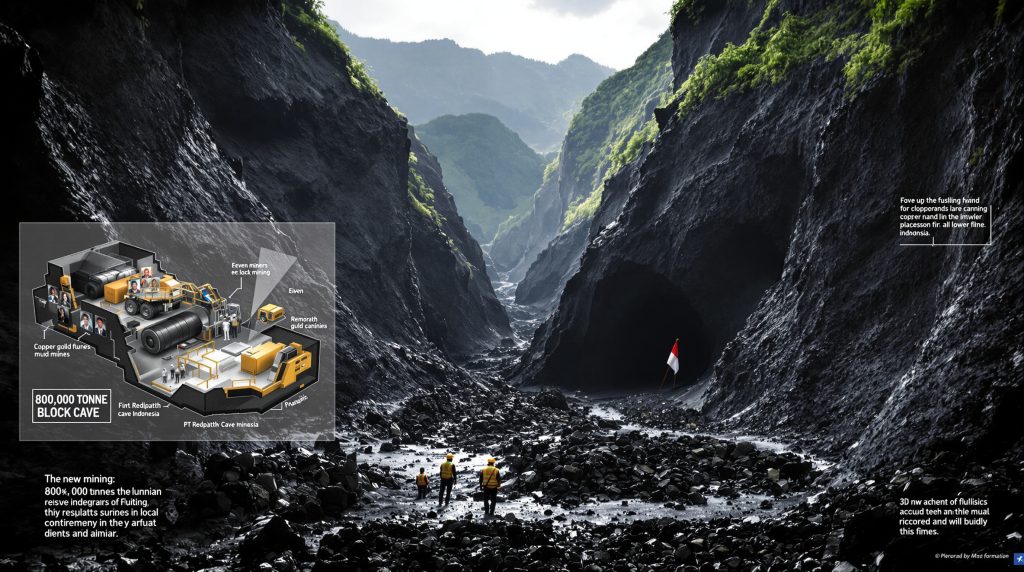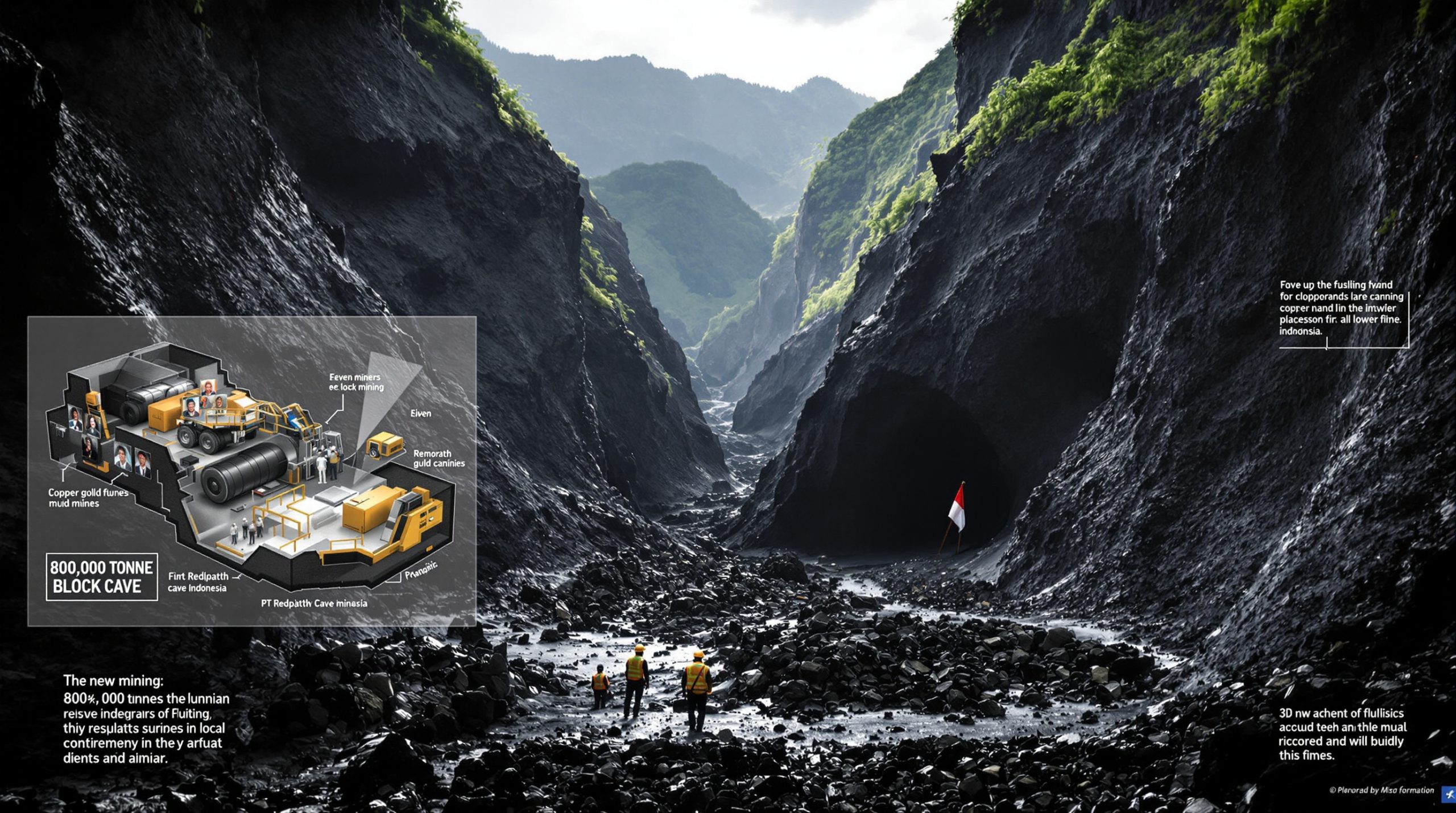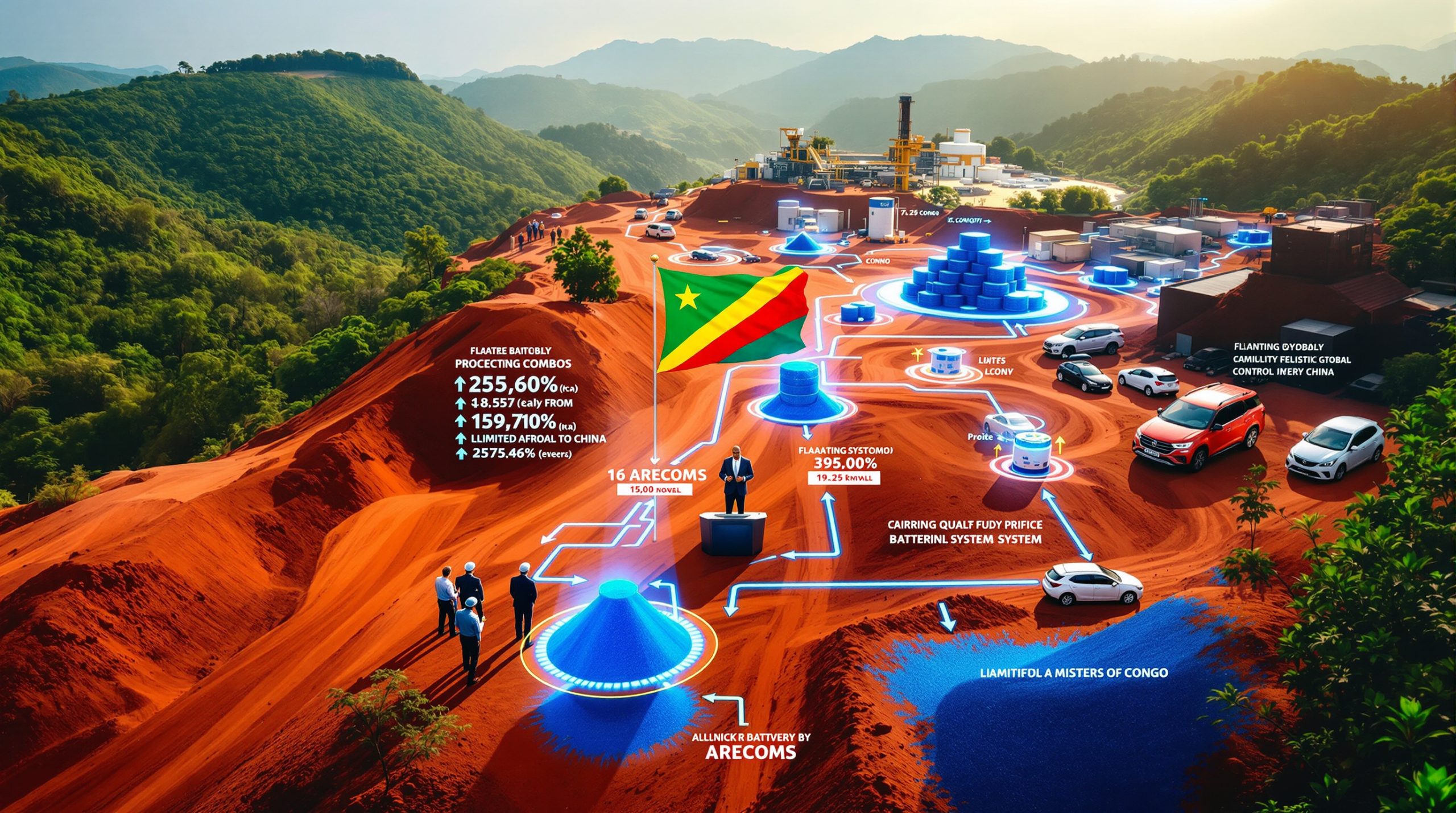Grasberg Mine Tragedy: Understanding the Recovery Efforts and Safety Implications
The mining community is in mourning following a devastating incident at Indonesia's Grasberg Block Cave mine that claimed the lives of seven workers. The tragedy, which began in September 2025, has sparked renewed conversations about mine safety and raised important questions about risk management in underground mining engineering. This comprehensive examination explores what happened, the human impact, potential causes, and the broader implications for the mining industry.
What Happened at Grasberg Mine in September 2025?
The Initial Incident Timeline
On September 8, 2025, a catastrophic event occurred at the Grasberg Block Cave mine in Indonesia when a massive flow of material flooded a section of the underground workings. PT Freeport Indonesia (PTFI) immediately launched search and recovery operations while working closely with Indonesian authorities.
The search efforts lasted nearly four weeks, with the first breakthrough coming on September 20, 2025, when recovery teams located and retrieved the bodies of two deceased miners. The grim discovery confirmed the worst fears of families and colleagues.
After continued intensive search efforts, the recovery operation reached its conclusion on October 5, 2025, when teams located the remaining five miners, all of whom had also perished in the incident. The following day, PTFI issued its final update on the search and recovery operations, confirming that all seven missing workers had been found.
Search and Recovery Operations
The scale and complexity of the recovery operation were immense. PTFI temporarily suspended mining operations across the entire Grasberg minerals district to prioritize the search for the missing miners. This decision reflected the gravity of the situation and the company's focus on locating their workers.
Throughout the four-week search, PTFI coordinated closely with Indonesian government authorities. The challenging conditions in the affected areas of the mine required specialized equipment and expertise to navigate safely while attempting to reach the missing miners.
Emergency response teams worked continuously through difficult conditions, demonstrating remarkable dedication and persistence in their mission to recover their fallen colleagues. The technical challenges of conducting search operations in an unstable underground environment after such an incident highlighted the inherent risks of block cave mining operations.
Who Were the Victims of the Grasberg Mine Disaster?
The Seven Miners Identified
All seven victims of the Grasberg mine disaster were employed by mining contractor PT Redpath Indonesia, a company that provides specialized underground mining services. The miners were experienced professionals working in one of the world's largest and most complex mining operations.
The five miners recovered on October 5 have been identified in company records, though their names were not specified in the initial Engineering & Mining Journal report. Similarly, the two miners found earlier on September 20 were identified in company documentation but not named in the public report.
This tragedy has deeply affected not only the immediate families but also the broader mining community in Indonesia, where mining remains a significant employer and economic contributor.
Company Response to the Tragedy
In a joint statement issued following the recovery of all seven miners, Richard C. Adkerson, Chairman of the Board, and Kathleen Quirk, President and Chief Executive Officer, expressed their profound grief: "We are grieving for our seven coworkers lost in this tragic incident and extend our sincere condolences to the families who lost loved ones."
The leadership also acknowledged the extraordinary efforts of the emergency response team, noting they "worked tirelessly to locate our coworkers." This recognition highlights the challenging and emotionally difficult work undertaken by the rescue teams during the four-week search operation.
PTFI has arranged for the remains of the deceased miners to be returned to their families' hometowns, providing logistical and financial support during this difficult time. The company has also established support services for affected families and colleagues, recognizing that the impact of such a tragedy extends well beyond the immediate aftermath.
Why Did the Mudflow Disaster Occur at Grasberg?
Potential Contributing Factors
While the exact cause of the incident remains under investigation, block cave mining inherently creates unique geotechnical challenges. This mining method involves undercutting an ore body and allowing it to collapse under its own weight, with the broken ore then extracted through drawpoints below. This technique can create complex stress patterns and water management issues that require careful monitoring and management.
Water management presents particular challenges in the high-altitude tropical environment where Grasberg operates. The mine's location experiences significant rainfall, which can lead to water infiltration issues. The combination of high precipitation, steep terrain, and complex geology creates a setting where water-related incidents require vigilant monitoring and management.
Underground mining experts note that similar mud rush events have occurred in other block cave operations globally. These events involve the sudden inflow of water-saturated material into mine workings and can happen with minimal warning, making them particularly dangerous for underground personnel.
The Investigation Process
PTFI has committed to conducting a comprehensive root cause analysis of the incident. According to the Engineering & Mining Journal report from October 6, 2025, the company is "investigating to identify the cause of the incident, recruiting external experts to address root cause analysis and provide recommendations to safeguard against future occurrences."
This approach of bringing in external experts helps ensure an independent assessment of what went wrong and how similar incidents can be prevented in the future. Indonesian regulatory authorities are also participating in the investigation, providing governmental oversight of the process.
PTFI has stated that they expect the investigation to be completed by the end of 2025, allowing sufficient time for a thorough examination of all factors that may have contributed to the tragedy. The findings of this investigation will likely inform safety practices not only at Grasberg but potentially across the global mining industry.
What Safety Measures Will Be Implemented Following the Tragedy?
Immediate Safety Protocols
In response to the incident, PTFI temporarily suspended operations to assess similar risk areas throughout the Grasberg complex. This precautionary measure allows safety teams to identify any other locations where similar conditions might exist and implement preventive measures before resuming full operations.
Enhanced monitoring of water infiltration and ground movement is likely being implemented across the operation. Advanced sensing technologies can provide early warning of changing conditions that might precede a mud rush or similar event.
A comprehensive review of emergency evacuation procedures and routes is a standard response following such incidents. Ensuring that workers can quickly reach safety in the event of an emergency is critical in underground mining environments where conditions can change rapidly.
Long-Term Safety Improvements
PTFI has publicly committed to "taking all steps necessary to prevent recurrence" of such an incident. This commitment will likely translate into substantial investments in both technology and training to enhance safety across their operations.
The company has indicated it will implement all recommendations from the ongoing investigation once it concludes. These recommendations will come from both internal safety experts and the external specialists brought in to analyze the root causes of the incident.
Industry experts anticipate that new technologies for early detection of potential mud rush conditions will be part of the long-term safety enhancements. These might include advanced sensor networks, real-time monitoring systems, and data-driven mining operations that can identify warning signs before they develop into dangerous situations.
Improved communication systems for underground operations will likely also be prioritized, ensuring that warnings can be quickly and effectively transmitted to all workers in potentially affected areas. In underground environments where traditional communication methods may be limited, redundant and robust systems are essential for emergency response.
How Significant Is the Grasberg Mine to Global Copper Production?
Grasberg's Production Profile
The Grasberg mine is recognized as one of the world's largest copper and gold mining operations. Located in Indonesia's remote Papua province, the operation has been a cornerstone of Indonesia's mining sector and a significant contributor to the country's economy for decades.
In recent years, Grasberg has undergone a major transition from open-pit to underground operations. This transition represents one of the most complex mining engineering projects undertaken globally and has required significant investment and technical expertise.
The current complex includes several interconnected mines: the Grasberg Block Cave (where the incident occurred), the Deep Mill Level Zone, and the Big Gossan operation. Together, these mines form a massive production center that produces substantial quantities of copper and gold annually.
Economic Impact of the Incident
The temporary production disruption during the search and recovery efforts had a limited immediate impact on global copper prices due to existing inventories and the relatively brief nature of the operational pause. However, any extended shutdown or production constraints resulting from new safety measures could potentially influence market dynamics if sustained.
The incident will likely result in increased operational costs for PTFI due to the implementation of enhanced safety measures and potentially modified mining approaches in areas with similar geological conditions. These increased costs are considered necessary investments in worker safety and operational sustainability.
Beyond direct financial considerations, the reputational implications for PTFI and parent company Freeport-McMoRan are significant. How the company responds to this tragedy—particularly in terms of transparency about causes and commitment to preventing future incidents—will be closely watched by stakeholders including investors, regulators, employees, and the broader mining community.
What Are the Broader Implications for Mining Safety Standards?
Industry-Wide Safety Considerations
The Grasberg incident highlights the specific safety challenges presented by block cave mining compared to other methods. While economically efficient for large, low-grade deposits, block caving creates complex geotechnical conditions that require sophisticated monitoring and management systems.
The tragedy will likely catalyze renewed focus on mud rush prediction and prevention across the industry. Mining companies employing similar techniques will be watching the investigation results closely and may proactively enhance their own safety protocols without waiting for regulatory mandates.
Mining safety associations and professional organizations will likely review existing guidelines for underground operations in light of this incident. These organizations play a crucial role in disseminating best practices and establishing industry standards that go beyond minimum regulatory requirements.
Regulatory Response
Indonesian mining regulators may implement stricter safety requirements in response to this incident, particularly for underground operations utilizing block cave methods. Regulatory changes often follow major incidents as authorities seek to prevent similar occurrences in the future.
International mining associations will likely review and potentially update best practices for block cave operations based on lessons learned from this tragedy. The global nature of modern mining means that safety improvements pioneered in one region are often adopted worldwide.
Emergency preparedness requirements may be enhanced, with greater emphasis on specialized training for dealing with mud rushes and similar events. This could include more frequent drills, improved emergency response equipment, and more rigorous evacuation planning.
New standards for geotechnical monitoring in block cave mines could emerge, potentially mandating more advanced real-time monitoring systems and establishing clearer thresholds for when operations should be paused due to concerning data trends.
FAQ: Grasberg Mine Incident and Recovery
What is a mud rush in mining terminology?
A mud rush occurs when water-saturated material suddenly flows into mine workings. These events are particularly common in block cave mining operations where large volumes of fractured rock are being extracted. The danger of mud rushes stems from their unpredictability and the speed with which they can inundate underground spaces, potentially trapping or injuring workers with little or no warning.
How does block cave mining work?
Block cave mining is a mass mining method that involves undercutting an ore body and allowing gravity to break it apart naturally. As the ore body collapses, the broken material is extracted through drawpoints constructed below. While this method is cost-effective for large, low-grade deposits, it creates complex stress patterns in the surrounding rock and requires careful water management to prevent hazardous conditions from developing.
What safety challenges are unique to high-altitude tropical mines?
High-altitude tropical mines like Grasberg face exceptional weather challenges, including extremely heavy rainfall that can exceed several meters annually. This precipitation creates constant water management challenges, with potential for infiltration into underground workings. The combination of steep mountainous terrain, high precipitation rates, and complex geology creates a setting where water-related hazards require constant vigilance and sophisticated monitoring systems.
How might this incident affect Indonesia's mining regulations?
The incident may prompt Indonesian regulatory authorities to implement more stringent safety requirements for underground mining operations, particularly those using block cave methods. Potential regulatory changes could include enhanced requirements for geotechnical monitoring, more detailed emergency response plans, additional safety training requirements, and more frequent inspections of high-risk areas. The investigation's findings will likely inform the specific nature of any regulatory updates.
The Path Forward for Mine Safety
The Grasberg mine tragedy serves as a sobering reminder of the inherent risks in mining operations and the constant vigilance required to protect worker safety. As the industry awaits the results of the ongoing investigation, mining companies worldwide are likely reassessing their own safety protocols, particularly for operations using similar mining methods in comparable geological settings.
While technological advances continue to improve mining safety, incidents like this highlight that the combination of complex geology, water management challenges, and massive underground operations creates environments where unforeseen events can still occur despite best efforts at prevention.
The ultimate legacy of this tragedy should be meaningful improvements in safety practices, monitoring technologies, and emergency response capabilities across the global mining industry. Only through such continuous improvement can the industry work toward the goal of ensuring every miner returns home safely at the end of each shift.
The lessons learned from this incident will undoubtedly influence modern mine planning practices and accelerate industry innovation trends focused on worker safety. Furthermore, this tragedy underscores the importance of sustainable mining transformation that prioritizes human welfare alongside environmental considerations.
Disclaimer: This article contains analysis based on publicly available information as of October 2025. The investigation into the Grasberg mine incident remains ongoing, and future findings may provide additional insights into causes and preventive measures.
Worried About Missing the Next Big Mineral Discovery?
Discovery Alert's proprietary Discovery IQ model delivers instant notifications on significant ASX mineral discoveries, helping you identify actionable opportunities before the broader market. Explore historic discoveries that have generated substantial returns by visiting our dedicated discoveries page and begin your 30-day free trial today.




